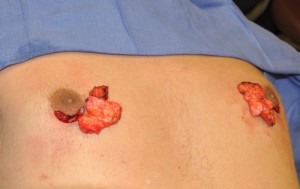Gynecomastia, or male breast enlargement, is a well known condition that affects both teenagers and adult men. While the majority of gynecomastia occurs in teenage boys, most of which can go away on its own, those that require surgery are more common in adult men over the age of eighteen. I do far more gynecomastia reduction surgery in men than in teenage boys.
While most people assume that gynecomastia surgery involves the reduction of large amounts of breast tissue, these types of male breast enlargements do not make up the majority of cases today. Men requesting gynecomastia reduction today are just as likely to come in for a relatively small amount of breast tissue that may just be underneath the nipple (areolar gynecomastia) or limited to just around it. The enlarged nipple-areolar complex is just as aesthetically distracting for many men as is a completely enlarged breast mound. This is also reflection of contemporary body styles and cultural standards of male beauty.
One very specific type of contemporary male breast concern that I see is ‘athletic gynecomastia’. This is seen in athletes, usually body builders, and often is the result of steroids and other muscle building supplements. The specific use of steroids or testosterone has the side effect of making the female hormone estrogen which stimulates breast tissue development. This creates a very firm breast tissue nodule which is easily felt right under the nipple. It is visually evident in a normal stance but protrudes out much further when lifting or posing as the flexed pectoralis muscle pushes it forward.

The approach to this type of gynecomastia is always through the lower half of the areola. This places the incision in the transition zone between the areola and the skin which makes for a well concealed scar. The scar will run between the 9 and 3 o’clock position. This will allow adequate access for directly excising the breast mass by electrocautery and doing liposuction to the two outside breast tissue zones. There is no need for any additional breast incisions. The wide undermining created by the liposuction also allows the skin surrounding the areola to shrink and adapt better.
Drains are almost always used for up to a week after surgery to prevent a fluid collection which can easily turn into hard scar tissue, creating minimal improvement afterwards. The use of a chest wrap is also important for the same reason and is worn for up to several weeks after surgery.
While there are the typical risks of gynecomastia surgery, such as hematoma, seroma, prominent areolar scar and nipple and chest irregularities, these are not the ones I emphasize to these types of gynecomastia patients.

Dr. Barry Eppley
Indianapolis, Indiana


